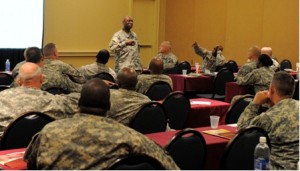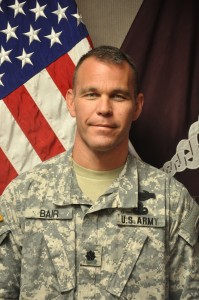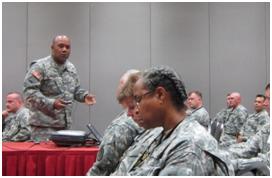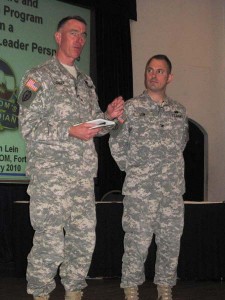By BG Darryl A. Williams, WTC Commander
It’s always great to see the Army Family come together. Last week was a whirlwind of reconnections, fun experiences, and meaningful opportunities. Sunday started at 0630 with the Army Ten-Miler. I met with our team for photos, gave them a send-off and met our wounded warriors as they crossed the finish line. One WTC employee told me that she was excited to run with the Missing Parts in Action team—current and past wounded, ill, and injured Soldiers who received treatment at Walter Reed—and especially enjoyed seeing them leave her in the dust. Rehabilitation at its best! The Warrior Transition Command and the Missing Parts teams were both impressive.
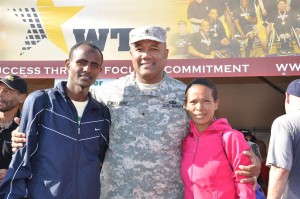
BG Darryl Williams, Warrior Transition Command Commander, congratulates world class runners Tesfaqe Sendekee, first overall male finisher, and Tezata Dengera, first overall female finisher at the 2011 Army Ten Miler (ATM) footrace. Both athletes competed for the 'I Run for God' (IR4G) team coached by LTC (Ret.) Sue Bozgoz. Each runner as well as additional IR4G runners donated their ATM trophies to WTC's Army wounded warriors.
I have to give a shout-out to everyone who participated but especially the International Running Team—I Run for God or IR4G. These men and women ran for wounded warriors and took first place overall, first place in the overall male category, and first, second and third places overall in the female categories. They very generously presented us their trophies on Thursday.
If you did not participate in the Army Ten-Miler, start making plans now for next year. It is a super event. I’m already talking to my team about all the ways we can ramp up our presence and get more folks involved. I ran into people I hadn’t seen in years, ate great food, and saw some excellent exhibits. I even heard some good music and saw a martial arts expo. It was an all-around festive time with Families, friends, and colleagues—two of my kids were with me and even they had a ball.
You all know that I’m adamant about making it clear that we represent and work for Active Duty, Guard and Reserve. To build on that—we were fortunate to share a Hooah Tent with Community-Based Warrior Transition Unit (CBWTU) Illinois. Kudos to all the runners and the volunteers who showed up to share education and information products, and talk to visitors about WTC and what we do every day to support wounded, ill and injured warriors. They also dished up a load of award-winning chili for runners and spectators—that was a big draw at our tent.
I had such a great time I didn’t think the week could get any better. Then on Monday I had the privilege of listening to the Secretary of the Army. While the Secretary did admit budget cuts sometimes keep him up at night, he also told us that unlike in the past, we saw this downturn coming and are better positioned than at any time in our nation’s history to deal with the fiscal realities, and do it in a way that truly makes sense. He reinforced that part of dealing with these realities is to cut end-strength and that our Army will look different than it does now. He emphasized that no conflict is ever won without boots on the ground and was confident the Army can handle the challenge of these pending reductions.
He addressed who we are and what we do when he said, “We’re still at war. We work diligently every day to try to make certain they get what they need, to get it when they need it, that we give them all the support they require to build resilience and all the care that’s necessary when they come home.”
For you history buffs, he was right on the money when he referenced the book “This Kind of War,” and TR Fehrenbach’s passage, “You may fly over land forever, you may bomb it, atomize it, pulverize it, and wipe it clean of life. But if you desire to defend it, protect it and keep it for civilization, you must do this on the ground the way the Roman legions did, by putting your young men into the mud.” He went on to acknowledge that “Fehrenbach’s observations are as relevant today as they ever were, because while we shocked, while we awed, at the end of the day, we did the most important thing to gain and ensure victory, we marched. And there is no getting around the fact that it is the Army that has been saddled with much of the burden these past years, providing between fifty to seventy percent of our deployable forces. And while I’m loathe to view our men and women in uniform as mere budgetary statistics, I think it’s important to remind people that while the United States Army represents half of our nation’s entire force, we consume only about a quarter to 30 percent of the entire defense budget.”
Later on Monday, I was on a panel with the Army Surgeon General, Deputy Surgeon General, and the FORSCOM Surgeon, Supporting the Deployment of Healthy, Resilient and Fit Soldiers…Soldier Medical Readiness. There was significant focus on how we identify and deal with non-medically ready Soldiers, and fitness and nutrition. It felt good to say that we return about 50 percent of our Warrior Transition Unit (WTU) Soldiers to duty and support all our wounded, ill and injured with a personalized Comprehensive Transition Plan that supports their goals to return to duty or transition out of military service.
Reflecting on the remarks by the Secretary and the Surgeon General on the future and resilience of our Army, I was reminded of who we are and how young we are. This command is only about two years old and we’ve only had WTUs since 2007. As the Surgeon General says, we are a learning organization and continuously changing. Our history is already rich with success and change. We went from medical hold companies to WTUs; from having no plan to the Army Medical Action Plan; from rehabilitation and therapy to Warrior Games. Very soon I’ll be sending out the new Comprehensive Transition Plan guidance for coordination and I’ll have new command information product—a newsletter, Warrior Care and Transition Program Update—coming your way soon.
Before I sign off, remember that in November we will celebrate Warrior Care Month across the Army. I want you all to be fully engaged as this is the most important monthly observance we have. The Warrior Care Month joint-service theme is “Healing the Mind, Body, and Spirit: Unlocking Unlimited Potential.” You all know better than anybody what this means and that these men and women embody strength and resilience. They are the products of prevention and research that resulted in more survivors of combat injures than ever before. My three priorities for these men and women are education, training, and careers. Let’s show the world who we are next month and what we do every day to support those who have given so much. It’s a time to highlight our wounded, ill and injured—Active, Guard and Reserve, and the people who support them.
I’d enjoy hearing about your Army Ten-Miler, AUSA experience and plans for Warrior Care Month. What stood out, and what we can do better on next year. Please post your comments on this blog by clicking on the headline and scrolling to the bottom of the page to the comment box.
In closing, I would recommend you check out the remarks of the Secretary and Chief of Staff of the Army during the annual AUSA meeting.

